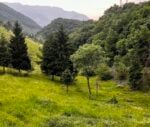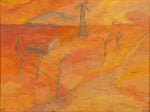Studio Formafantasma – Delta
 (320x480).jpg)
La mostra presenta la collezione inedita di arredi che i FORMAFANTASMA – Andrea Trimarchi e Simone Farresin, talentuoso duo di designer italiani, giovani ma già ampiamente apprezzati dalla critica e dalla stampa internazionale – hanno disegnato in esclusiva per la galleria.
Comunicato stampa
Delta is a collection of objects fruit of the collaboration between the Roman Design Gallery Giustini / Stagetti Galleria O. Roma and Formafantasma. The project, curated by Domitilla Dardi, senior curator at Maxxi in Roma, is part of the CONTEMPORARY DESIGN gallery’s program ’Privato Romano Interno’ curated by Emanuela Nobile Mino that since 2012 with the first collection designed by Fernando and Humberto Campana, commissions international designers to use Rome as a source of inspiration for new furniture pieces.
A selection of works have been produced by Fonderia Artistica Battaglia, Milano.
What: Delta
The delta of a river is a landform that forms from deposition of debris carried by water over millennia. More then referring directly to river Tevere which is the main watercourse of Rome, the title of the collection expresses the characteristic mix of architectural styles of the city that as sediments have layered over the centuries.
As often in their work the designers found knowledge in the past: almost as in a study-trip to the city, Formafantasma visited the numerous Roman archeological venues and museums and accumulated a large numbers of photos and documents that over the year-long process to design the collection have become the fondation of their work. During this time a clear selection of materials emerged made of marbles, metals, porcelain and wood and the collection is composed by a large number of lights, some vessels a oil lantern, a cabinet and a mirror.
The designers have been particularly attracted by very mundane objects of the Imperial Rome and while some artifacts shown in the museums have served as inspiration, others have been directly sampled and carefully updated for the contemporary use. In the case of the porcelain pieces for instance the designers decided to change as little as possible in the forms and even the chosen colors are a very clear reference to the history of Roman pottery: In contrast to contemporary fashion, red was used for almost 500 years and black for other 500. The only addition to the very sober pallet is a subtile off-white color.
Differently the lights are in most cases pairing travertine stone with brass. In one of the pieces, a thin LED lighting disc is hanged in front of another one in stone, formally recalling the central opening in the Pantheon ceiling while the light reflected on the travertine recreates the very peculiar feeling of the sun illuminating Roman buildings. The Helmet light, a composition of curved brass pieces placed on a electrified plate, is designed in such a way to remove the switch and transform the action of activating the light in a gesture: via turning the top wings in different positions the light goes either on or off.
While working on the project the rigorous beauty of the ruins that survived over the centuries stripped down of almost any decoration and the functional perfection of the utilitarian objects conserved in the museums, appeared to the designers as extremely contemporary and naturally connected in the design attitude to some of the 20th century rational architecture built in Rome. Because of this especially in the cabinet, the gridded wood containers mounted on the travertine structure recalls both the marble benches on the terrace of the ‘Palace of Congress’ by Adalberto Libera and Luigi Moretti’s SGI building at the EUR area in Rome.
Delta as a collection result as a coherent body of work that more then delivering a portrait of a city, it uses design to draw unexpected links between historical periods in search for timelessness.



